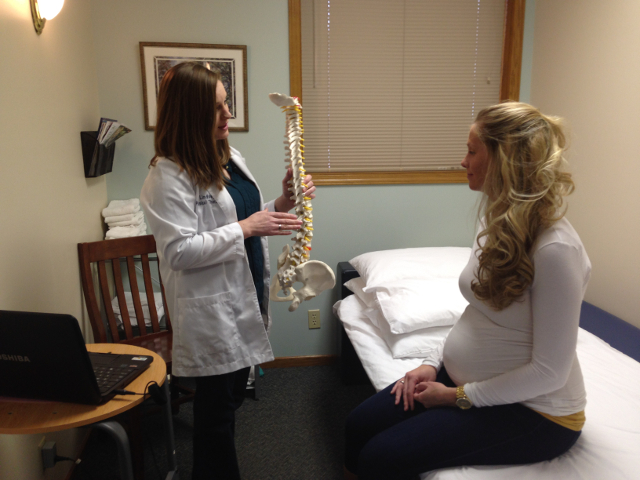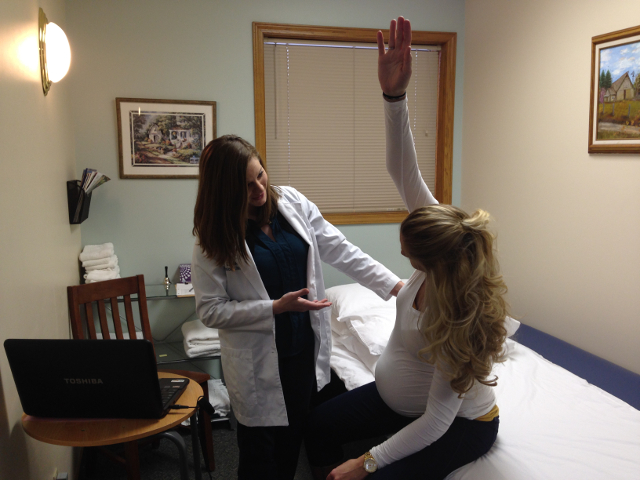Instruction in proper abdominal exercise, for example, will aid pushing in delivery, speed recovery, improve abdominal muscle tone and prevent low-back pain after delivery.
Ailments common in pregnancy are treatable through physical therapy programs designed by Midwest Physical Therapy Services – which follow American College of Obstetricians and Gynecologists (ACOG) guidelines – include:

Upper and Lower Back Pain:
Changes in muscular structure and posture during pregnancy can cause back pain, either general or localized, constant or intermittent. Although common during pregnancy, back pain should not be attributed to pregnancy alone and should be closely examined. Discomfort during pregnancy is normal; pain is not.
-
To reduce discomfort in the back, including the mid-back and neck, a physical therapist may recommend and/or provide the following:
- Exercise
- Massage
- Cold/heat treatment
- Belts or supports
- Relaxation techniques
- Instruction in proper lifting, pushing/pulling
- Education about posture
Tingling Sensations
Slight numbness or tingling in the arms or legs may result from swelling during pregnancy. An exercise program directed by a physical therapist can help relieve these sensations while strengthening muscles and promoting circulation. A physical therapist also may recommend the use of joint supports or suggest ways to improve positioning to relieve the tingling sensation.
Joint Problems
Previous orthopedic problems may become aggravated during pregnancy. A physical therapist aware of a patient’s previous orthopedic problems can offer instruction in proper exercise to help reduce pain in the affected joints. In addition to corrective exercise, a therapist also may use heat/ice, massage and instruction in safe rest/work positions and the use of orthopedic supports.
Pain After Caesarean or Eposiotomy
Physical therapy that includes an abdominal strength program can enhance recovery from surgical procedures involved in childbirth as well as tears and hemorrhoids. In addition to exercise designed for strength and improved posture, physical therapy treatment may include instruction in ways to avoid strain while resting or moving, relieve discomfort from gas distention and properly care for perineal or abdominal incisions.
A physical therapist may use moist heat packs, scar massage and ultrasound to increase the patient’s comfort after these procedures.
When muscles – bowel, bladder, respiratory, abdominal or perineal – are weakened by these surgical procedures, a physical therapist may monitor the mother’s musculoskeletal structure after pregnancy and establish an exercise program to strengthen the involved muscles.
Pelvic Floor Weakness
Physical therapy can greatly enhance the strength of the pelvic floor, which also helps prevent incontinence during and after pregnancy. A number of techniques are used to strengthen the pelvic floor, including exercise and education on its functioning.
Other Sources of Discomfort
-
Pregnancy may bring various other discomforts suitable for treatment by a physical therapist. Relief can be provided for pain associated with:
- Sacral-Iliac Dysfunction – usually noticed as pain on one side above buttock region.
- Pubic Symphysis Strain – accompanied by pain in the groin area, often felt while standing on one leg.
- Sciatica – results in pain, numbness or tingling in one or both legs.
- Coccygodynia – brings pain in the tail bone, especially when sitting.

Special Concerns
Women who have been confined to bed during pregnancy may be helped to maintain their general physical condition with physical therapy. Education is a large part of a treatment program designed to offset the effects of prolonged bed rest, without stressing the abdominal muscles.
Post-partum pain, secondary to episiotomies may also be addressed through the clinic. Immediately post-partum, severe episiotomies or tears respond well to treatment with ultrasound and electrical stimulation in the clinic setting and also patient instruction to scar massage to the area. Intervention within the first 48 hours post-partum is optimal, however if pain persists beyond four to six weeks post-partum, patients should seriously consider treatment.

